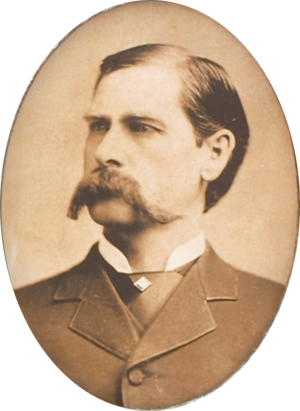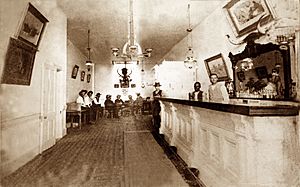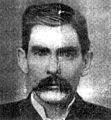Doc Holliday facts for kids
Quick facts for kids
Doc Holliday
|
|
|---|---|
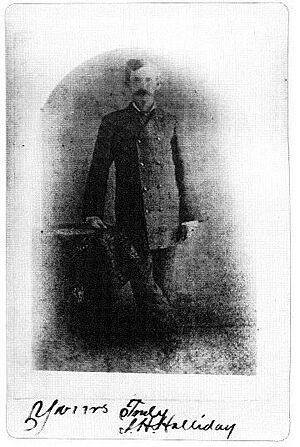
Autographed portrait, Prescott, Arizona, c. 1879
|
|
| Born |
John Henry Holliday
August 14, 1851 Griffin, Georgia, U.S.
|
| Died | November 8, 1887 (aged 36) |
| Resting place | Pioneer Cemetery (a.k.a. Linwood Cemetery), Glenwood Springs, Colorado, U.S. |
| Education | Pennsylvania College of Dental Surgery |
| Occupation | dentist, professional gambler, gunfighter |
| Known for | Gunfight at the O.K. Corral Earp Vendetta Ride |
| Spouse(s) |
"Big Nose" Kate Horony (common-law wife)
(m. 1877–1882) |
John Henry Holliday (August 14, 1851 – November 8, 1887), better known as Doc Holliday, was an American dentist, gambler, and gunfighter who was a close friend and associate of lawman Wyatt Earp. Holliday is best known for his role in the events surrounding and his participation in the Gunfight at the O.K. Corral in Tombstone, Arizona. He developed a reputation as having killed more than a dozen men in various altercations, but modern researchers have concluded that, contrary to popular myth-making, Holliday killed only one to three men. Holliday's colorful life and character have been depicted in many books and portrayed by well-known actors in numerous movies and television series.
At age 20, Holliday earned a degree in dentistry from the Pennsylvania College of Dental Surgery. He set up practice in Griffin, Georgia, but he was soon diagnosed with tuberculosis, the same disease that had claimed his mother when he was 15 and his sister before his birth, having acquired it while tending to his mother's needs. Hoping the climate in the American Southwest would ease his symptoms, he moved to that region and became a gambler, a reputable profession in Arizona in that day. Over the next few years, he reportedly had several confrontations. He saved Wyatt Earp's life during a saloon confrontation in Texas, and they became friends. In 1879, he joined Earp in Las Vegas, New Mexico, and then rode with him to Prescott, Arizona, and then Tombstone. While in Tombstone, local members of the outlaw Cochise County Cowboys repeatedly threatened him and spread rumors that he had robbed a stagecoach. On October 26, 1881, Holliday was deputized by Tombstone city marshal Virgil Earp. The lawmen attempted to disarm five members of the Cowboys near the O.K. Corral on the west side of town, which resulted in the famous shootout.
Following the Tombstone shootout, Virgil Earp was maimed by hidden assailants while Morgan Earp was killed. Unable to obtain justice in the courts, Wyatt Earp took matters into his own hands. As the recently appointed deputy U.S. marshal, Earp formally deputized Holliday, among others. As a federal posse, they pursued the outlaw Cowboys they believed were responsible. They found Frank Stilwell lying in wait as Virgil boarded a train for California and Wyatt Earp killed him. The local sheriff issued a warrant for the arrest of five members of the federal posse, including Holliday. The federal posse killed three other Cowboys during late March and early April 1882, before they rode to the New Mexico Territory. Wyatt Earp learned of an extradition request for Holliday and arranged for Colorado Governor Frederick Walker Pitkin to deny Holliday's extradition. Holliday spent the few remaining years of his life in Colorado. He died of tuberculosis in his bed at the Hotel Glenwood at age 36.
Contents
Early life and education
Holliday was born in Griffin, Georgia, to Henry Burroughs Holliday and Alice Jane (McKey) Holliday. He was of English and Scottish ancestry. His father served in the Mexican–American War and the American Civil War (as a major in the 27th Georgia Infantry). When the Mexican–American War ended, Henry brought home an adopted son named Francisco. Holliday was baptized at the First Presbyterian Church of Griffin in 1852. In 1864, his family moved to Valdosta, Georgia, where his father would be elected mayor and his mother would die of tuberculosis on September 16, 1866. The same disease killed his adopted brother. Three months after his wife's death, his father married Rachel Martin.
Holliday attended the Valdosta Institute, where he received a classical education in rhetoric, grammar, mathematics, history, and languages—principally Latin, but some French and Ancient Greek.
In 1870, 19-year-old Holliday left home for Philadelphia. On March 1, 1872, at age 20, he received his Doctor of Dental Surgery degree from the Pennsylvania College of Dental Surgery (now part of the University of Pennsylvania School of Dental Medicine). Holliday graduated five months before his 21st birthday, so the school held his degree until he turned 21, the minimum age required to practice dentistry.
Adulthood
Career
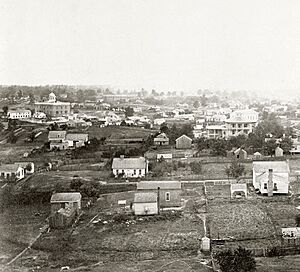
Holliday moved to St. Louis, Missouri, so he could work as an assistant for his classmate, A. Jameson Fuches, Jr. Less than four months later, at the end of July, he relocated to Atlanta, where he joined a dental practice. He lived with his uncle and his family so he could begin to build up his dental practice. A few weeks before Holliday's birthday, dentist Arthur C. Ford advertised in the Atlanta papers that Holliday would substitute for him while Ford was attending dental meetings.
Diagnosis of tuberculosis
Shortly after beginning his dental practice, Holliday was diagnosed with tuberculosis. He was given only a few months to live, but was told that a drier and warmer climate might slow the deterioration of his health. After Dr. Ford's return in September, Holliday left for Dallas, Texas, the "last big city before the uncivilized Western Frontier".
Move to Dallas
When he arrived in Dallas, Holliday partnered with a friend of his father's, Dr. John A. Seegar. They won awards for their dental work at the Annual Fair of the North Texas Agricultural, Mechanical and Blood Stock Association at the Dallas County Fair. They received all three awards: "Best set of teeth in gold", "Best in vulcanized rubber", and "Best set of artificial teeth and dental ware." Their office was located along Elm Street, between Market and Austin Streets. They dissolved the practice on March 2, 1874. Afterward, Holliday opened his own practice over the Dallas County Bank at the corner of Main and Lamar Streets.
With coughing spells at inopportune times from his tuberculosis, his dental practice slowly declined. Meanwhile, Holliday found he had some skill at gambling and he soon relied on it as his principal income source. On May 12, 1874, Holliday and 12 others were indicted in Dallas for illegal gambling. He was arrested in Dallas in January 1875 after trading gunfire with a saloon keeper, Charles Austin, but no one was injured and he was found not guilty. He moved his offices to Denison, Texas, but after being fined for gambling in Dallas, he left the state.
Heads farther west
Holliday headed to Denver, Colorado, following the stage routes and gambling at towns and army outposts along the way. During the summer of 1875, he settled in Denver under the alias "Tom Mackey" and found work as a faro dealer for John A. Babb's Theatre Comique at 357 Blake Street. He got into an argument with Bud Ryan, a well-known and tough gambler. They drew knives and fought and Holliday left Ryan seriously wounded.
Holliday left when he learned about gold being discovered in Wyoming. On February 5, 1876, he arrived in Cheyenne, Wyoming. He found work as a dealer for Babb's partner, Thomas Miller, who owned the Bella Union Saloon. In the autumn of 1876, Miller moved the Bella Union to Deadwood, South Dakota (site of the gold rush in the Dakota Territory), and Holliday went with him.
In 1877, Holliday returned to Cheyenne, then Denver, and eventually to Kansas, where he visited an aunt. When he left Kansas, he went to Breckenridge, Texas, where he gambled. On July 4, 1877, after a disagreement with gambler Henry Kahn, Holliday beat him repeatedly with his walking stick. Both men were arrested and fined, but Kahn was not finished. Later that same day, he shot and seriously wounded the unarmed Holliday. On July 7, the Dallas Weekly Herald incorrectly reported that Holliday had been killed. His cousin, George Henry Holliday, moved west to help him recover.
Once healed, Holliday relocated to Fort Griffin, Texas. While dealing cards at John Shanssey's saloon, he met Mary Katharine "Big Nose Kate" Horony, a dance hall woman. She is the only woman with whom Holliday is known to have had a relationship.
Befriends Wyatt Earp
In October 1877, outlaws led by "Dirty" Dave Rudabaugh robbed a Santa Fe Railroad construction camp in Kansas. Rudabaugh fled south into Texas. Wyatt Earp was given a temporary commission as deputy U.S. marshal. Earp left Dodge City, following Rudabaugh over 400 mi (640 km) to Fort Griffin, a frontier town on the Clear Fork of the Brazos River. Earp went to the Bee Hive Saloon, the largest in town and owned by John Shanssey, whom Earp had met in Wyoming when he was 21. Shanssey told Earp that Rudabaugh had passed through town earlier in the week, but he did not know where he was headed. Shanssey suggested Earp ask gambler Doc Holliday, who had played cards with Rudabaugh. Holliday told Earp that he thought Rudabaugh was headed back to Kansas. Earp sent a telegram to Ford County Sheriff Bat Masterson that Rudabaugh might be headed back in his direction.
After about a month in Fort Griffin, Earp returned to Fort Clark and in early 1878, he went to Dodge City, where he became the assistant city marshal, serving under Charlie Bassett. During the summer of 1878, Holliday and Horony also arrived in Dodge City, where they stayed at Deacon Cox's boarding house as Dr. and Mrs. John H. Holliday. Holliday sought to practice dentistry again, and ran an advertisement in the local paper:
DENTISTRY
J. H. Holliday, Dentist, very respectfully offers his professional services to the citizens of Dodge City and surrounding country during the summer. Office at Room No. 24 Dodge House. Where satisfaction is not given, money will be refunded.
According to accounts of the following event, reported by Glenn Boyer in I Married Wyatt Earp, Earp had run two cowboys, Tobe Driscall and Ed Morrison, out of Wichita earlier in 1878. During the summer, the two cowboys—accompanied by another two dozen men—rode into Dodge and shot up the town while galloping down Front Street. They entered the Long Branch Saloon, vandalized the room, and harassed the customers. Hearing the commotion, Earp burst through the front door and before he could react, a large number of cowboys were pointing their guns at him. In another version, there were only three to five cowboys. In both stories, Holliday was playing cards in the back of the room and upon seeing the commotion, drew his weapon and put his pistol at Morrison's head, forcing him and his men to disarm, rescuing Earp from a bad situation. No account of any such confrontation was reported by any of the Dodge City newspapers at the time. Whatever actually happened, Earp credited Holliday with saving his life that day, and the two men became friends.
Move to New Mexico
Holliday developed a reputation for his skill with a gun, as well as with the cards. A few days before Christmas in 1878, Holliday and Horony arrived in Las Vegas, New Mexico. The 22 hot springs near the town were favored by individuals with tuberculosis for their alleged healing properties. Doc opened a dental practice and continued gambling as well, but the winter was unseasonably cold and business was slow. The New Mexico Territorial Legislature passed a bill banning gambling within the territory with surprising ease. On March 8, 1879, Holliday was indicted for "keeping [a] gaming table" and was fined $25. The ban on gambling combined with extremely low temperatures persuaded him to return to Dodge City for a few months.
In September 1879, Wyatt Earp resigned as assistant marshal in Dodge City. Accompanied by his common-law wife Mattie Blaylock, his brother Jim, and Jim's wife Bessie, they left for Arizona Territory. Holliday and Horony returned to Las Vegas where they met again with the Earps. The group arrived in Prescott in November.
Royal Gorge War
In Dodge City, Holliday joined a team being formed by Deputy U.S. Marshal Bat Masterson. Masterson had been asked to prevent an outbreak of guerrilla warfare between the Atchison, Topeka and Santa Fe Railway and the Denver and Rio Grande Western Railroad (D&RGW), which were vying to be the first to claim a right-of-way across the Royal Gorge, one of the few natural routes through the Rockies that crossed the Continental Divide. Both were striving to be the first to provide rail access to the boom town of Leadville, Colorado. Royal Gorge was a bottleneck along the Arkansas, too narrow for both railroads to pass through, and with no other reasonable access to the South Park area. Doc remained there for about two and a half months. The federal intervention prompted the so-called "Treaty of Boston" to end the fighting. The D&RGW completed its line and leased it for use by the Santa Fe. Holliday took home a share of a $10,000 bribe paid by the D&RGW to Masterson to give up their possession of the Santa Fe roundhouse and returned to Las Vegas where Horony had remained.
Builds saloon in Las Vegas
The Santa Fe Railroad built tracks to Las Vegas, New Mexico, but bypassed the city by about a mile. A new town was built up near the tracks and and gambling flourished there. On July 19, 1879, Holliday and John Joshua Webb, former lawman and gunman, were seated in a saloon. Former U.S. Army scout Mike Gordon tried to persuade one of the saloon girls, a former girlfriend, to leave town with him. She refused and Gordon left the building "shouting obscenities", followed by Holliday. Gordon fired a shot at Holliday and subsequently "Gordon died" the day after. The next day, Holliday paid $372.50 to a carpenter to build a clapboard building to house the Doc Holliday's Saloon with John Webb as his partner. While in town, he was fined twice for keeping a gambling device, and again for carrying a deadly weapon.
Move to Arizona Territory
It appeared Holliday and Horony were settling into life in Las Vegas when Wyatt Earp arrived on October 18, 1879. He told Holliday he was headed for the silver boom going on in Tombstone, Arizona Territory. Holliday and Horony joined Wyatt and his wife Mattie, as well as Jim Earp and his wife and stepdaughter, and they left the next day for Prescott, Arizona Territory. They arrived within a few weeks and went straight to the home of Constable Virgil Earp and his wife Allie. Holliday and Horony checked into a hotel and when Wyatt, Virgil, and James Earp with their wives left for Tombstone, Holliday remained in Prescott, where he thought the gambling opportunities were better. Holliday finally joined the Earps in Tombstone in September 1880. Some accounts report that the Earps sent for Holliday for assistance with dealing with the outlaw Cowboys. Holliday quickly became embroiled in the local politics and violence that led up to the Gunfight at the O.K. Corral in October 1881.
Arrives in Colorado
On May 15, 1882, Holliday was arrested in Denver on the Tucson warrant for murdering Frank Stilwell. When Wyatt Earp learned of the charges, he feared his friend Holliday would not receive a fair trial in Arizona. Earp asked his friend Bat Masterson, then chief of police of Trinidad, Colorado, to help get Holliday released. Masterson drew up bunco charges against Holliday.
Holliday's extradition hearing was set for May 30. Late in the evening of May 29, Masterson sought help getting an appointment with Colorado Governor Frederick Walker Pitkin. He contacted E.D. Cowen, capital reporter for the Denver Tribune, who held political sway in town. Cowen later wrote, "He submitted proof of the criminal design upon Holliday's life. Late as the hour was, I called on Pitkin." His legal reasoning was that the extradition papers for Holliday contained faulty legal language and that there was already a Colorado warrant out for Holliday—including the bunco charge that Masterson had fabricated. Pitkin was persuaded by the evidence presented by Masterson and refused to honor Arizona's extradition request.
Masterson took Holliday to Pueblo, where he was released on bond two weeks after his arrest. Holliday and Wyatt met again in June 1882 in Gunnison after Wyatt helped to keep his friend from being convicted on murder charges regarding Frank Stillwell. Holliday was able to see his old friend Wyatt one last time in the late winter of 1886, where they met in the lobby of the Windsor Hotel. Sadie Marcus described the skeletal Holliday as having a continuous cough and standing on "unsteady legs."
Holliday spent his remaining days in Colorado. After a stay in Leadville, he suffered from the high altitude. He increasingly depended on medication to ease the symptoms of tuberculosis, and his health and his skills as a gambler began to deteriorate.
Final days and death
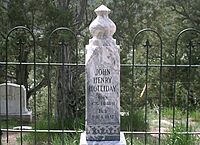
In 1887, prematurely gray and badly ailing, Holliday made his way to the Hotel Glenwood, near the hot springs of Glenwood Springs, Colorado. He hoped to take advantage of the reputed curative power of the waters, but the sulfurous fumes from the spring might have done his lungs more harm than good. As he lay dying, Holliday is reported to have asked the nurse attending him for a shot of whiskey. When she told him no, he looked at his bootless feet, amused. The nurses said that his last words were, "This is funny." He always figured he would be killed someday with his boots on. Holliday died at 10 a.m. on November 8, 1887. He was 36. Wyatt Earp did not learn of Holliday's death until two months afterward. Kate Horony later said that she attended to him in his final days, and one contemporary source appears to corroborate her claim. He died from tuberculosis.
Memorial service
The Glenwood Springs Ute Chief of November 12, 1887, wrote in its obituary that Holliday had been baptized in the Catholic Church. This was based on correspondence written between Holliday and his cousin, Sister Mary Melanie, a Catholic nun. No baptismal record has been found in either St. Stephen's Catholic Church in Glenwood Springs or at the Annunciation Catholic Church in nearby Leadville.
Holliday's mother had been raised a Methodist and later joined a Presbyterian church (her husband's faith), but objected to the Presbyterian doctrine of predestination and re-converted to Methodism publicly before she died, saying that she wanted her son John to know what she believed. Holliday himself was later to say that he had joined a Methodist church in Dallas. At the end of his life, Holliday had struck up friendships with both a Catholic priest, Father E.T. Downey, and a Presbyterian minister, Rev. W.S. Randolph, in Glenwood Springs. When he died, Father Downey was out of town, and so Rev. Randolph presided over the burial at 4 p.m. on the same day that Holliday died. The services were reportedly attended by "many friends".
Burial
Holliday is buried in Linwood Cemetery overlooking Glenwood Springs. Since Holliday died in November, the ground might have been frozen. Some modern authors such as Bob Boze Bell speculate that it would have been impossible to transport him to the cemetery, which was only accessible by a difficult mountain road, or to dig a grave because the ground was frozen. Author Gary Roberts located evidence that other bodies were transported to the Linwood Cemetery at the same time of the month that year. Contemporary newspaper reports explicitly state that Holliday was buried in the Linwood Cemetery, but the exact location of his grave is uncertain. Though there is no official evidence of this, some claim that Holliday's father, Major Henry Holliday, a man of means and influence, had his son exhumed and re-buried in Griffin's Oak Hill Cemetery.
Public reputation
Holliday maintained a fierce persona as was sometimes needed for a gambler to earn respect. He had a contemporary reputation as a skilled gunfighter which modern historians generally regard as accurate. Holliday reported that he had been arrested 17 times, four attempts had been made to hang him, and that he survived ambush five times.
Character
Throughout his lifetime, Holliday was known by many of his peers as a tempered, calm, Southern gentleman. In an 1896 article, Wyatt Earp said: "I found him a loyal friend and good company. He was a dentist whom necessity had made a gambler; a gentleman whom disease had made a vagabond; a philosopher whom life had made a caustic wit; a long, lean blonde fellow nearly dead with consumption and at the same time the most skillful gambler and nerviest, speediest, deadliest man with a six-gun I ever knew."
In a newspaper interview, Holliday was once asked if his conscience ever troubled him. He is reported to have said, "I coughed that up with my lungs, years ago."
Masterson wrote that Holliday was quick to go for his gun when threatened.
Stabbings and shootings
Much of Holliday's violent reputation was nothing but rumors and self-promotion. However, he showed great skill in gambling and gunfights. His tuberculosis did not hamper his ability as a gambler and as a marksman. Holliday was ambidextrous.
No contemporaneous newspaper accounts or legal records offer proof of the many unnamed men whom Holliday is credited with killing in popular folklore. The only men he is known to have killed are Mike Gordon in 1879; probably Frank McLaury and Tom McLaury in Tombstone; possibly Frank Stilwell in Tucson; and William Allen in Colorado. Some scholars argue that Holliday may have encouraged the stories about his reputation, although there is no evidence he did.
Photos of Holliday
Three photos of unknown provenance are often reported to be of Holliday, some of them supposedly taken by C.S. Fly in Tombstone, but sometimes reported to have been taken in Dallas. Holliday lived in a rooming house in front of Fly's photography studio. Many persons share similar facial features, and the faces of people who look radically different can look similar when viewed from certain angles. Because of this, most museum staff, knowledgeable researchers, and collectors require provenance or a documented history for an image to support physical similarities that might exist. Experts rarely offer even a tentative identification of new or unique images of famous people based solely on similarities shared with other known images.
-
Cropped from a larger version, Holliday's graduation photo from the Pennsylvania School of Dental Surgery in March 1872, age 20, known provenance and authenticated as Holliday
-
Cropped from a larger version, Holliday in Prescott, Arizona in 1879, age 27, known provenance and authenticated as Holliday
-
Person with a bowler hat and open vest and coat, unknown provenance
Legacy
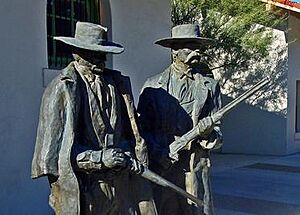
Doc Holliday is one of the most recognizable figures in the American Old West, but he is most remembered for his friendship with Wyatt Earp and his role in the Gunfight at the O.K. Corral. Holliday's friendship with the lawman has been a staple of popular sidekicks in American Western culture, and Holliday himself became a stereotypical image of a deputy and a loyal companion in modern times. He is typically portrayed in films as being loyal to his friend Wyatt, whom he sticks with during the duo's greatest conflicts, such as the Gunfight at the OK Corral and Earp's vendetta, even with the ensuing violence and hardships that they both endured. Together with Wyatt Earp, Doc Holliday has become a modern symbol of loyalty, brotherhood and friendship.
The home of Doc Holliday’s uncle is marked with a historical marker located in Fayetteville, Georgia.
A life-sized statue of Holliday and Earp by sculptor Dan Bates was dedicated by the Southern Arizona Transportation Museum at the restored Historic Railroad Depot in Tucson, Arizona, on March 20, 2005, the 122nd anniversary of the killing of Frank Stilwell by Wyatt Earp. The statue stands at the approximate site of the shooting on the train platform.
"Doc Holliday Days" are held yearly in Holliday's birthplace of Griffin, Georgia. Valdosta, Georgia held a Doc Holliday look-alike contest in January 2010, to coincide with its sesquicentennial celebration.
Tombstone, Arizona also holds an annual Doc Holli-Days, which started in 2017 and celebrates the gunfighter-dentist on the 2nd weekend of August each year. Events include gunfights, a parade, and a Doc Holliday look-alike contest. Val Kilmer, who played Doc in 1993's Tombstone, was the grand marshal in 2017 and Dennis Quaid, who played Doc in 1994's Wyatt Earp, was the grand marshal in 2018.
See also
 In Spanish: Doc Holliday para niños
In Spanish: Doc Holliday para niños



